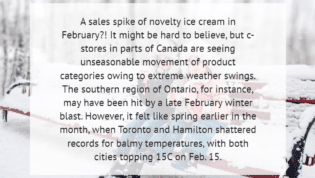Forecasting demand: A surge in ice cream sales left some c-store owners scratching their heads this winter
By Chris Daniels
Experts share strategies for managing unexpected weather-driven purchasing patterns.
…On the flip side, rising mercury at this time of year can stop movement of winter products dead in their tracks.
For instance, sales of ice melt in the Greater Toronto Area plummeted year-over-year in February 2023 by 24%, according to an analysis by Berwyn, PA-based Planalytics, a global predictive demand analytics firm focused on weather.
Across the rest of Canada, the category was down 6%.
Clearly, weather can have a significant impact on retail sales. Evan Gold, executive vice-president, global partnerships and alliances at Planalytics, says “anywhere from 2% to 5% of a lot of businesses’ top-line sales can be driven by the weather.”
That could be 5% growth – or decline.
“The real kicker is when you look at individual product categories. Different weather is going to drive different purchasing at different times of the year for every category,” notes Gold.
Managing the weather
So how can c-stores harness weather volatility and drive sales? For starters, Gold suggests they take advantage of their loyalty programs and social media channels to put out highly relevant messaging.
That could be to promote a fresh salad or slushy treat during a temperature spike or a hot soup and sandwich during a cold snap.
He also says brands are more than willing to work with retailers on promotions that drive sales during their slower months….
Demand forecasting is a part of getting “season-ready,” whether winter, spring, summer or fall. C-stores, including Little Short Stop Stores, leverage historical sales data to calculate how much inventory to order….
…When it comes to inventory forecasting, however, Gold recommends a weather-based cleanse of your sales history. If you’re a store or chain in southwestern Ontario, that would likely mean removing that record high day in February for planning next winter’s inventory figures.
“If you don’t remove that volatile day from your sales history, you’re essentially planning for that same weather, and the odds are it is very unlikely to happen the very next year,” says Gold. “When you remove it, we analyze how much you should add back in to come up with an inventory plan.”
To read the original article, Click Here.
For more information about Planalytics, Contact Us.

